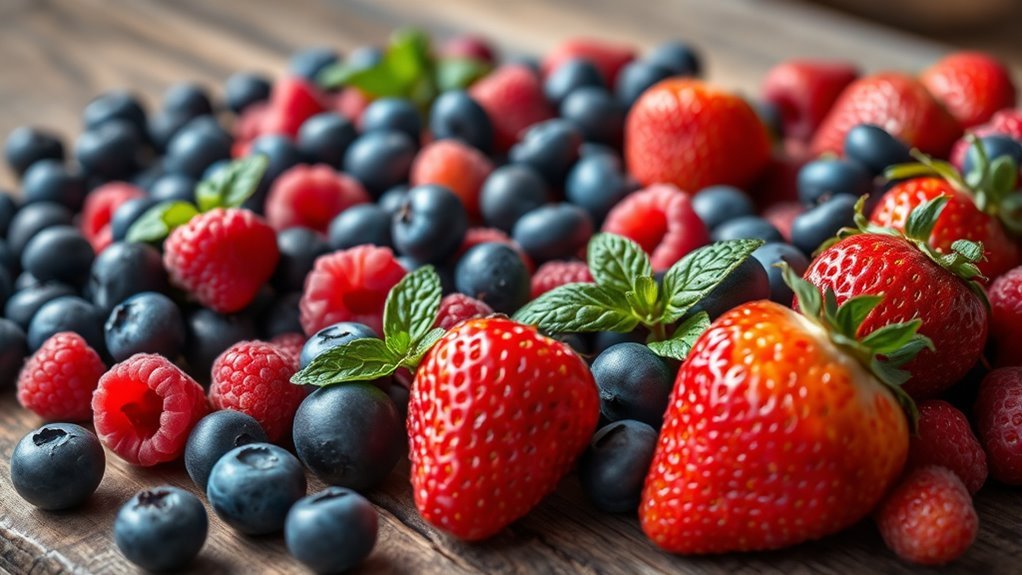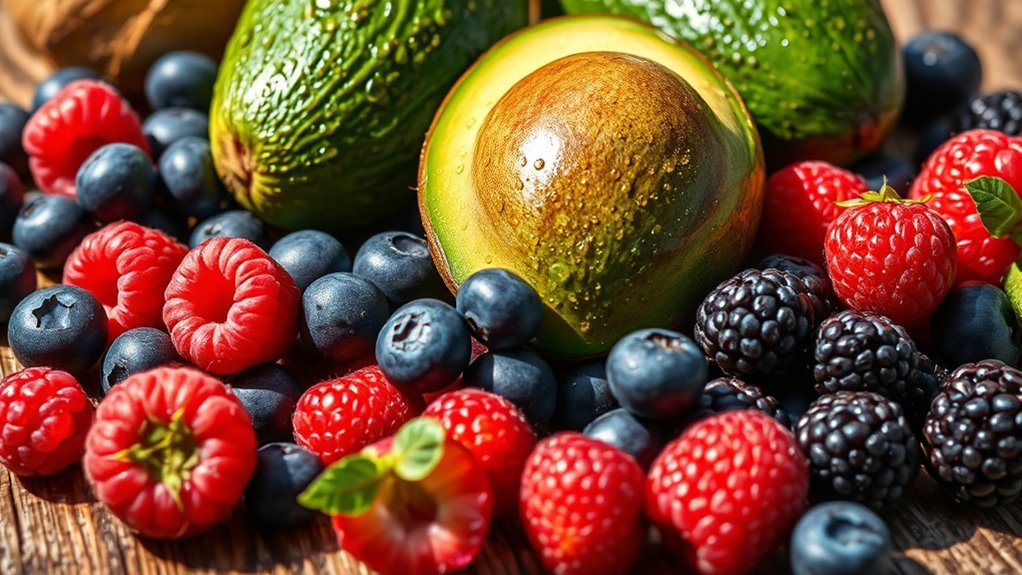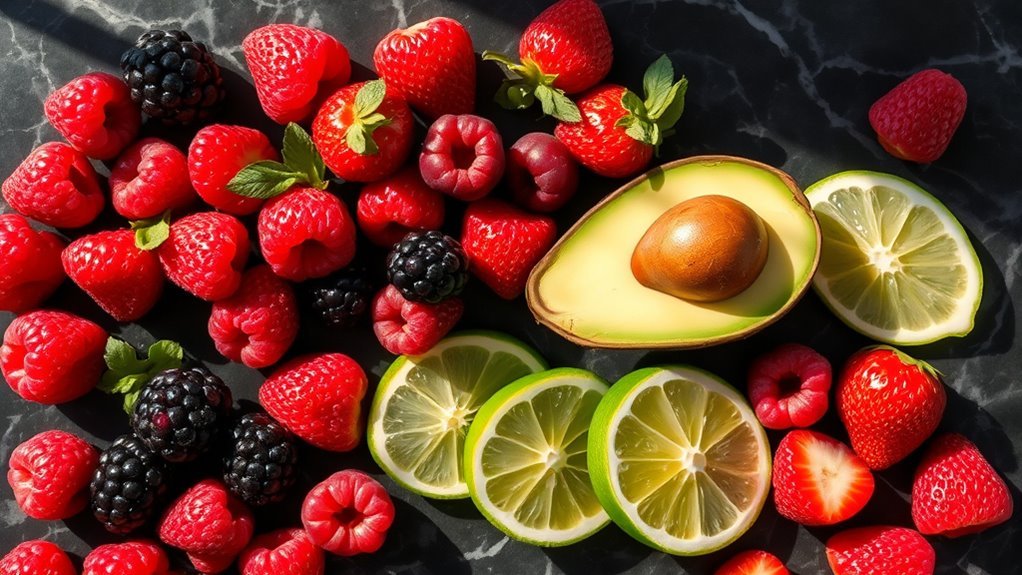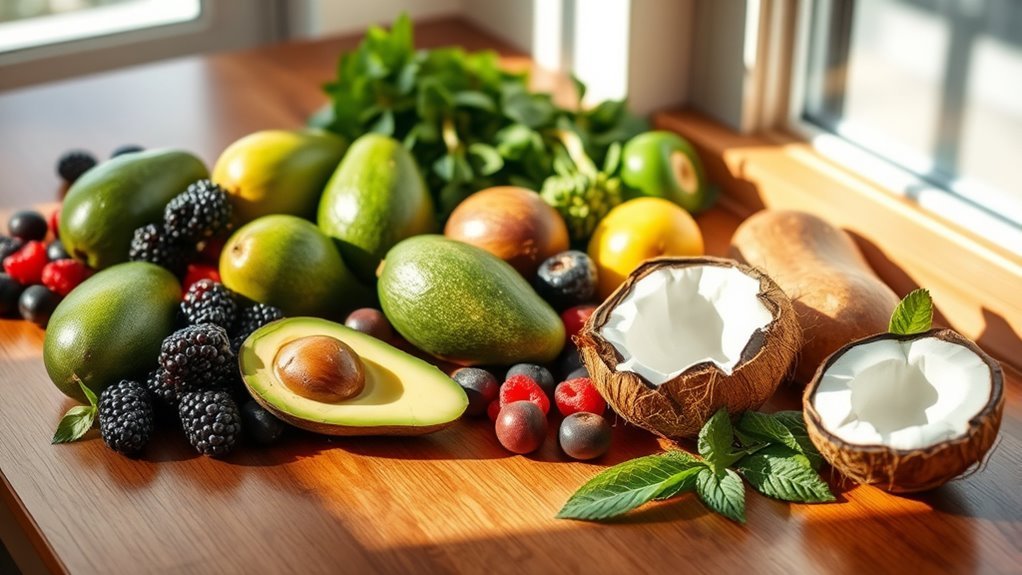Yes, fruit can be part of a ketogenic diet, but you’ll need to choose wisely. Low-carb options like berries and avocados fit well within your carb limits, while high-carb fruits like bananas and grapes should be avoided. It’s crucial to monitor your portion sizes and carb intake to maintain ketosis. If you’re curious about creative ways to incorporate these fruits into your meals, there’s so much more to explore for a balanced keto lifestyle.
Understanding the Ketogenic Diet

When you’re exploring the ketogenic diet, it’s vital to understand its fundamental principles. The keto diet emphasizes high fat, moderate protein, and very low carbohydrate intake, aiming to shift your body into ketosis, where it burns fat for fuel. However, there are several keto misconceptions, particularly regarding fruit. Many believe that all fruits are off-limits due to their sugar content, but this isn’t entirely true. Certain fruits, like berries, can offer nutritional benefits while fitting into a keto plan when consumed in moderation. They provide essential vitamins, minerals, and antioxidants that support your overall health. Balancing these benefits with your carb limits is key to enjoying fruits while maintaining ketosis, promoting a sense of freedom in your dietary choices.
The Carbohydrate Content of Fruits

Understanding the carbohydrate content of fruits is key for anyone on a ketogenic diet. Different fruit types vary markedly in their carbohydrate sources, affecting your daily carb intake. For instance, berries like strawberries and raspberries typically have lower carbohydrate levels compared to bananas and grapes, which can be higher in sugars. While fruits provide essential vitamins and fiber, their carb content can impact ketosis. If you’re aiming to stay within your carb limits, it’s vital to choose fruits wisely. By knowing which fruits are lower in carbohydrates, you can enjoy the benefits of fruits without compromising your ketogenic goals. Always consider the portion sizes, as even low-carb fruits can add up if consumed in large quantities.
Low-Carb Fruits to Consider

If you’re following a ketogenic diet and want to include fruits, there are several low-carb options that can fit seamlessly into your meal plan. Berries, for instance, are packed with antioxidants and have notable health benefits. Just remember to enjoy them in moderation to stay within your carb limits. Here’s a quick reference to help you choose:
| Fruit | Carbs (per 100g) | Benefits |
|---|---|---|
| Raspberries | 5.5g | High in fiber |
| Strawberries | 7.7g | Rich in vitamin C |
| Blackberries | 9.6g | Loaded with antioxidants |
| Blueberries | 14.5g | Good for brain health |
| Avocado | 8.5g | Healthy fats and fiber |
Incorporating these fruits can enhance your diet while keeping your carb intake in check.
High-Carb Fruits to Avoid
While low-carb fruits can be a delightful addition to your ketogenic diet, it’s equally important to be aware of high-carb fruits that can hinder your progress. Fruits like bananas, grapes, and cherries are packed with high sugar content and can quickly kick you out of ketosis. Even though they’re delicious, indulging in these high-sugar fruits might sabotage your efforts to maintain a low-carb lifestyle. Instead, consider ketogenic alternatives such as berries, avocados, and olives, which provide essential nutrients without excessive carbs. By being selective and informed, you can enjoy the freedom of incorporating fruits into your diet while staying on track with your ketogenic goals. Remember, moderation is key, so make conscious choices for lasting success.
The Glycemic Index and Its Importance
The glycemic index (GI) measures how foods affect your blood sugar levels. Understanding GI is essential, especially when making fruit choices on a keto diet, as some fruits can spike your blood sugar more than others. By focusing on fruits with a lower GI, you can better manage your carb intake while still enjoying healthy options.
Understanding Glycemic Index
Understanding the glycemic index (GI) is essential for anyone steering through dietary choices, especially on a keto diet. The GI measures how quickly foods raise your blood sugar levels, which directly affects your glycemic response. When you consume high-GI foods, they can spike your blood sugar, leading to increased insulin release. This can be particularly challenging for those aiming to improve insulin sensitivity. On a keto diet, you want to minimize those spikes to maintain stable energy levels and promote fat burning. By choosing low-GI fruits and foods, you can enjoy more freedom in your dietary selections while keeping your body aligned with your keto goals. Balancing GI with your keto lifestyle can empower you to make informed choices.
Impact on Blood Sugar
When you’re following a keto diet, it’s crucial to grasp the impact of various foods on your blood sugar levels. The glycemic index (GI) measures how foods affect blood sugar regulation. Foods with a high GI can spike your blood sugar, leading to a significant insulin response, which isn’t ideal on a keto diet.
Here’s a quick reference table to help you understand:
| Food Type | Glycemic Index (GI) |
|---|---|
| Low GI (e.g., nuts) | 0-55 |
| Moderate GI (e.g., berries) | 56-69 |
| High GI (e.g., bananas) | 70+ |
Choosing low-GI fruits can help maintain steady blood sugar levels, allowing you more freedom in your keto journey and reducing the risk of insulin spikes.
Fruit Choices for Keto
Choosing the right fruits while on a keto diet can be tricky, especially since many popular options are high in sugars that can disrupt ketosis. That’s where the glycemic index (GI) comes into play. By focusing on lower-GI fruit varieties, you can enjoy fruits without compromising your diet. Berries like strawberries, raspberries, and blackberries are excellent choices, as they’re lower in carbs and high in fiber. Seasonal fruits like avocados and lemons are also keto-friendly and can add variety to your meals. Remember, moderation is key. You don’t have to completely eliminate fruit; just be mindful of your choices. By understanding the GI and selecting wisely, you can enjoy the freedom of incorporating fruits into your keto lifestyle.
Portion Control and Serving Sizes
Although fruits can be a healthy addition to your diet, managing portion control and serving sizes is essential for those following a ketogenic lifestyle. Keeping track of how much fruit you consume helps maintain your carb limits while still enjoying nature’s sweets.
Here’s a quick reference table for common fruits and their serving sizes:
| Fruit | Serving Size (grams) |
|---|---|
| Raspberries | 123 |
| Strawberries | 152 |
| Blackberries | 144 |
| Avocado | 100 |
| Watermelon | 154 |
Creative Ways to Incorporate Fruits
When you’re following a keto diet, finding ways to enjoy fruit without exceeding your carb limits can be a challenge. You can explore low-carb fruit options, try fruit-infused keto recipes, or whip up creative snack ideas that satisfy your sweet tooth. By incorporating these strategies, you can enjoy the benefits of fruit while staying aligned with your dietary goals.
Low-Carb Fruit Options
As you explore low-carb fruit options, you’ll find that there are plenty of creative ways to incorporate these tasty treats into your keto lifestyle without sacrificing your carbohydrate limits. Berries, such as strawberries, raspberries, and blackberries, are excellent choices due to their lower sugar content. You can blend them into delicious keto smoothies, adding a creamy base like almond milk or coconut cream. Another fantastic option is to create vibrant fruit salads featuring a mix of these berries, along with some chopped nuts for added crunch. By choosing low-carb fruits, you can enjoy the natural sweetness and nutrients they offer while staying within your daily carb allowance. Embrace these options to satisfy your cravings and maintain your keto journey!
Fruit-Infused Keto Recipes
If you’re looking to add a burst of flavor to your keto meals, fruit-infused recipes can be a delightful way to do so. Here are three creative ideas to get you started:
- Fruit Smoothies: Blend low-carb fruits with spinach or avocado for a nutrient-packed drink.
- Citrus Salsas: Combine diced avocados with citrus fruits for a zesty topping on grilled chicken or fish.
- Keto Jams: Make your own jams using berries and a low-carb sweetener to spread on almond flour bread.
You can also whip up invigorating infused waters, berry salads, and coconut bowls. Don’t forget about flavored yogurts or seasonal fruit dishes to keep your meals exciting. These recipes guarantee you enjoy the freedom of flavor while staying on track with your keto lifestyle!
Creative Snack Ideas
Finding creative ways to incorporate fruits into your keto snacking routine can be both enjoyable and nutritious. One delicious option is fruit smoothies. Blend low-carb fruits like berries with coconut milk or almond milk for a revitalizing treat. You can also add spinach or avocados for extra nutrients without greatly increasing carbs. Another idea is to enjoy dried fruits in moderation—opt for unsweetened varieties like coconut flakes or small amounts of dried blueberries. They can satisfy your sweet tooth while adding flavor to your snacks. Pair these with nuts for a balanced mix of healthy fats and fiber. Remember, moderation is key on your keto journey, so keep track of your carb intake while enjoying these fruity delights!
Balancing Fruits With a Keto Lifestyle
While it might seem challenging to incorporate fruits into a keto lifestyle due to their natural sugars, striking a balance is entirely possible with careful selection and moderation. Here are some tips to help you achieve that keto balance:
- Opt for Low-Carb Fruits: Focus on berries, avocados, and tomatoes, which are lower in sugar and high in fiber.
- Watch Your Portions: Even keto-friendly fruits can add up in carbs. Keep serving sizes small to maintain your macros.
- Pair with Healthy Fats: Combine fruits with nuts or cheese to slow down sugar absorption and enhance satisfaction.


